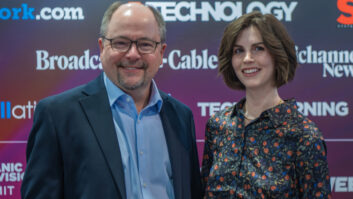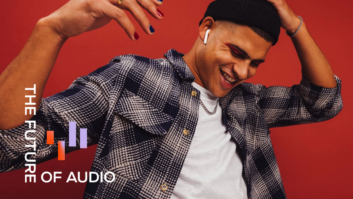Surround takes to the airwaves
Dec 1, 2004 12:00 PM, By Mike Pappas
On Sept. 24 KUVO radio broadcast the first-ever 5.1 surround live performance using the HD Radio system. Using the Harris Neustar 5225 (designed by Neural Audio) watermark two-dimensional downmix system, KUVO broadcast three-time Grammy-winner Dianne Reeves with the Colorado Symphony Orchestra (CSO) live.

Photo by Grant Leighton
Getting there
As the first FM HD Radio station in Colorado, KUVO was looking for ways to promote HD Radio. As part of this we teamed up with Ultimate Electronics Sound Track to raise awareness and provide our listeners with an outlet where they could obtain radios. As part of this program, Ultimate Electronics underwrote the Reeves/CSO broadcast with help from Kenwood Electronics. The funding side of the project was covered.
Now we needed to address the technical aspects. I had heard a demo of the Harris Neustar 5225 system at the Neural facility in Seattle, and I was impressed. The 5225 system is a DSP-based watermarked two-dimensional downmixing system. The 5225 is fed left, right, center, low-frequency extension (LFE), left surround and right surround via AES-3 digital inputs, and it produces an AES-3 watermarked stereo signal.
The 5225 is not a matrix system. I listened to stereo/quad systems during the early 80s, and during my career in television I used several matrix systems to make surround and they all have serious technical problems. The primary problem is a lack of image stability. With matrix systems images shift back and forth and front to back and this was not acceptable.

The stage being set for the performance and broadcast. Photo by Grant Leighton.
Other proposed 5.1 radio implementations are fully discrete. Everything is handled as six channels of audio. In a digital facility this requires three AES-3 lines per source. Modifying the KUVO facility to support discrete 5.1 was economically infeasible.
For the broadcast we created a mix in 5.1, ran it through the 5225 and shipped the downmixed, watermarked signal as conventional stereo. This would be the signal that our analog FM and stereo HD Radio listeners would hear.
The Reeves CSO concert was held at the Boettcher Concert Hall at the Denver Performing Arts Complex. We started our planning with a site survey in August.

Mike Pappas and Gregor Zielinsky, artist relations manager for Sennheiser, at the console during a rehearsal.
Boettcher concert hall is a theater-in-the-round with seating on all sides of the stage. It has more than three seconds of reverb time and seats 2,500 on three levels. Our first challenges were to decide the location of the 5.1 control room and then install the ISDN lines. Additionally, we had to schedule our load-in and set up around the CSO rehearsal schedule while working with the IATSE stagehands crew. We examined the stage, the possible cable runs and the available dressing rooms to estimate the cable runs and the announcer locations.
In the meantime, we prepared a block diagram of the system and started collecting the equipment we were going to need to make this happen.
Our initial plan was to use a 5.1 analog console as the music mixer. We quickly discovered that there were no small-format analog 5.1 consoles available. Because I didn’t want to use a digital mixer, our backup plan was to use a mixer with left/center/right capability and use the auxiliary outputs for the LFE and rear surround channels.
We obtained an Allen and Heath ML-3000 with 32 inputs, L/C/R capability and eight aux outputs (outputs 7 and 8 are stereo, which we used for the rear surround channels) that would cover our needs.

The KUVO setup at the concert hall. Click here to enlarge this image.
Bonding ISDN lines
I was concerned about the best way to get the signal back to the studio. It didn’t make a lot of sense to kill ourselves making great audio at the concert hall if we couldn’t get it back to the studios. I looked at bonding a pair of ISDN lines to increase the fidelity of our signal and found that APT makes a series of ISDN codecs that would bond up to four ISDN lines. I arranged with Kevin Campbell at APT to audition a pair of the APT Tokyo codecs. The audio quality with a pair of ISDN lines (256kb/s) while using the Apt-x Enhanced encoding was outstanding. Strings sounded like strings and the delay was less than 4ms. As a result of our testing we ordered a pair of the codecs and had ordered two ISDN lines.
We also started working on a preliminary input list and our input block diagram. We used our three Neumann Solution D digital microphones as our main L/C/R array. Our plan was to run the Solution D at 88.2kHz/28 bits and up-sample them to Direct Stream Digital (DSD) using our EMM Labs converters. DSD is the Sony ultra high-resolution digital format that samples at 64 times the sample rate of a standard CD. The DSD clock rate of 2.8224MHz is 32 times the Solution D sample rate of 88.2 and our EMM Labs converters are switchable to handle the up sampling.

The transmission rack housed the Harris Neustar encoder, APT codec, Sony DAT and some stereo confidence monitoring equipment.
For the rear surround channels we used our Neumann KU-100 stereo dummy head microphone that we nicknamed Fritz. The union riggers hung Fritz for us about � of the way back in the hall. The mic lines were dropped at the preamp stage left.
We planned for highlight mics for the first and second violins, first viola and cello, a pair of Sennheiser MKH-800 mics for center fill, and mics for Dianne Reeves’ trio. We used a total of 23 inputs.
Cue the announcers
This was the biggest remote in the history of KUVO and we were going to have a pre-concert show, first-half concert, 20-minute intermission, second-half concert and post-concert show. Programming requested the capability to have four announcers on-air with the ability to run prepackaged segments. They also wanted to provide pop-ins live from the venue starting at noon the day of the broadcast. Figuring that the music mixer (Justin Peacock) was going to have his hands more than full I decided that it would be easier to have a talent mixer located with the announcers in the back of the hall to feed a stereo sub mix. We used a Yamaha 01V96 mixer with the optional AES/EBU card as the sub mixer. A Sony and a Denon CD player were provided to run the prepackaged segments.
We decided to pre-build the system at KUVO prior to load-in to make sure that everything was going to work as planned. We had all the cables and adapters we would need to interface everything. During this pre-build we discovered that the Yamaha mixer expected all the sources to be word-clock locked. I expected the Yamaha to have sample-rate converters. This was a nasty surprise because the Denon CD players don’t have sync input. Nick Caseras, the talent mixer, came up with an elegant work around using the Denon as the master clock via its AES-3 output and slaved the Sony CD player, which had sync input, to the Yamaha. It was a good thing we tried this before arriving at the site.

The mic locations for the orchestra. Click here to enlarge this image.
We don’t do a lot of large symphony work and I wanted this to be as close to perfect as possible. I called Sennheiser in Germany and requested that they send Gregor Zielinsky to assist us. Zielinsky is a tonmeister and spent 16 years with Deutsche Grammaphon producing classical recordings. He and I worked together on several other 5.1 projects in the past. Sennheiser agreed and Zielinsky was scheduled to arrive the day of load-in.
The setup
We loaded in and built the control room on Sept. 22. On Sept. 23 we miked the stage and constructed the announcer positions. At 7:30 p.m. that day the first rehearsal started and we were ready to go. At 9 a.m. on Friday, Sept. 24 we were back with the second rehearsal. We went live with pop-in interviews with Dianne Reeves at 12:15 p.m.
The broadcast went live at 7:28 p.m., and the concert started at 7:30 p.m. We monitored the broadcast in 5.1 and confidence checked the Neural 5225 two-channel output. We also monitored our analog FM and HD Radio signals in stereo and in decoded 5225 5.1. The audio was out of this world. The 5225 made great-sounding stereo from our 5.1 mix and the APT Tokyo was flawless. We went back to the studio at 10:25 p.m. that evening.
Because we were all ready set up, we recorded the Saturday evening performance. It was just a matter of swapping the hard drive for a clean one in the 40-track Genex DSD recorder and hitting the record button. We knocked down after the Saturday night performance and our truck arrived back at KUVO by midnight.

Two of the many mics used to capture the live event. This is the stereo pair in the center of the orchestra.
We learned a lot on this project and we are looking forward to doing more 5.1 projects using the Neural 5225 system. The CSO management and Dianne Reeves were knocked out with the sound quality of the broadcast. KUVO received dozens of calls and e-mails from our listeners about how great it sounded. Surround via HD Radio is a reality now with the Neural 5225 system and you don’t need to rewire your whole world to support it. This is a major breakthrough in being able to broadcast 5.1 using all of the conventional stereo equipment that is already in place.
Pappas is chief engineer of KUVO, Denver.
Microphone list
Main Middle LMKH-800 Main Middle RMKH-800 1st violinMKH-50 2nd violinMKH-800 ViolaTLM-193 CelloMKH-50 Double BassMKH-40 PercussionTLM-127 Timpani/bass drumTLM-127 KickTLM-103 Drums overheadKM-184 Piano (x2)MKH-800 LeftSolution-D CenterSolution-D RightSolution-D Binaural headKU-100 Reeves voiceKMS-105 Neumann and Sennheiser mics were used to capture the event.












